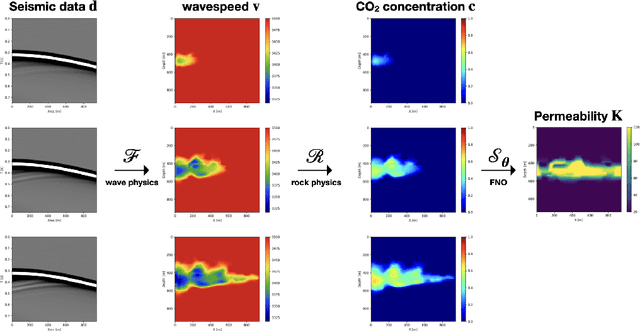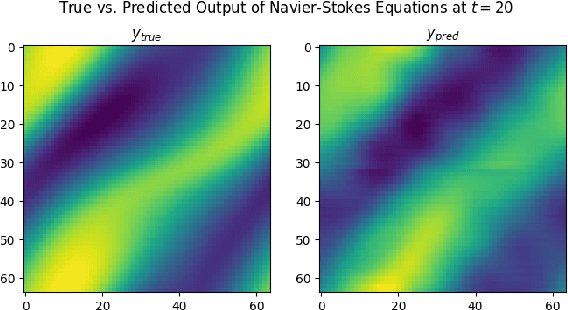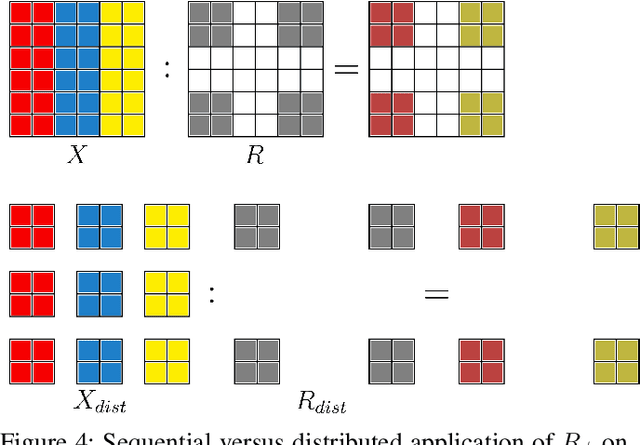Mathias Louboutin
Machine learning-enabled velocity model building with uncertainty quantification
Nov 14, 2024Abstract:Accurately characterizing migration velocity models is crucial for a wide range of geophysical applications, from hydrocarbon exploration to monitoring of CO2 sequestration projects. Traditional velocity model building methods such as Full-Waveform Inversion (FWI) are powerful but often struggle with the inherent complexities of the inverse problem, including noise, limited bandwidth, receiver aperture and computational constraints. To address these challenges, we propose a scalable methodology that integrates generative modeling, in the form of Diffusion networks, with physics-informed summary statistics, making it suitable for complicated imaging problems including field datasets. By defining these summary statistics in terms of subsurface-offset image volumes for poor initial velocity models, our approach allows for computationally efficient generation of Bayesian posterior samples for migration velocity models that offer a useful assessment of uncertainty. To validate our approach, we introduce a battery of tests that measure the quality of the inferred velocity models, as well as the quality of the inferred uncertainties. With modern synthetic datasets, we reconfirm gains from using subsurface-image gathers as the conditioning observable. For complex velocity model building involving salt, we propose a new iterative workflow that refines amortized posterior approximations with salt flooding and demonstrate how the uncertainty in the velocity model can be propagated to the final product reverse time migrated images. Finally, we present a proof of concept on field datasets to show that our method can scale to industry-sized problems.
ASPIRE: Iterative Amortized Posterior Inference for Bayesian Inverse Problems
May 08, 2024Abstract:Due to their uncertainty quantification, Bayesian solutions to inverse problems are the framework of choice in applications that are risk averse. These benefits come at the cost of computations that are in general, intractable. New advances in machine learning and variational inference (VI) have lowered the computational barrier by learning from examples. Two VI paradigms have emerged that represent different tradeoffs: amortized and non-amortized. Amortized VI can produce fast results but due to generalizing to many observed datasets it produces suboptimal inference results. Non-amortized VI is slower at inference but finds better posterior approximations since it is specialized towards a single observed dataset. Current amortized VI techniques run into a sub-optimality wall that can not be improved without more expressive neural networks or extra training data. We present a solution that enables iterative improvement of amortized posteriors that uses the same networks architectures and training data. The benefits of our method requires extra computations but these remain frugal since they are based on physics-hybrid methods and summary statistics. Importantly, these computations remain mostly offline thus our method maintains cheap and reusable online evaluation while bridging the approximation gap these two paradigms. We denote our proposed method ASPIRE - Amortized posteriors with Summaries that are Physics-based and Iteratively REfined. We first validate our method on a stylized problem with a known posterior then demonstrate its practical use on a high-dimensional and nonlinear transcranial medical imaging problem with ultrasound. Compared with the baseline and previous methods from the literature our method stands out as an computationally efficient and high-fidelity method for posterior inference.
InvertibleNetworks.jl: A Julia package for scalable normalizing flows
Dec 20, 2023Abstract:InvertibleNetworks.jl is a Julia package designed for the scalable implementation of normalizing flows, a method for density estimation and sampling in high-dimensional distributions. This package excels in memory efficiency by leveraging the inherent invertibility of normalizing flows, which significantly reduces memory requirements during backpropagation compared to existing normalizing flow packages that rely on automatic differentiation frameworks. InvertibleNetworks.jl has been adapted for diverse applications, including seismic imaging, medical imaging, and CO2 monitoring, demonstrating its effectiveness in learning high-dimensional distributions.
Solving multiphysics-based inverse problems with learned surrogates and constraints
Jul 18, 2023Abstract:Solving multiphysics-based inverse problems for geological carbon storage monitoring can be challenging when multimodal time-lapse data are expensive to collect and costly to simulate numerically. We overcome these challenges by combining computationally cheap learned surrogates with learned constraints. Not only does this combination lead to vastly improved inversions for the important fluid-flow property, permeability, it also provides a natural platform for inverting multimodal data including well measurements and active-source time-lapse seismic data. By adding a learned constraint, we arrive at a computationally feasible inversion approach that remains accurate. This is accomplished by including a trained deep neural network, known as a normalizing flow, which forces the model iterates to remain in-distribution, thereby safeguarding the accuracy of trained Fourier neural operators that act as surrogates for the computationally expensive multiphase flow simulations involving partial differential equation solves. By means of carefully selected experiments, centered around the problem of geological carbon storage, we demonstrate the efficacy of the proposed constrained optimization method on two different data modalities, namely time-lapse well and time-lapse seismic data. While permeability inversions from both these two modalities have their pluses and minuses, their joint inversion benefits from either, yielding valuable superior permeability inversions and CO2 plume predictions near, and far away, from the monitoring wells.
Refining Amortized Posterior Approximations using Gradient-Based Summary Statistics
May 15, 2023Abstract:We present an iterative framework to improve the amortized approximations of posterior distributions in the context of Bayesian inverse problems, which is inspired by loop-unrolled gradient descent methods and is theoretically grounded in maximally informative summary statistics. Amortized variational inference is restricted by the expressive power of the chosen variational distribution and the availability of training data in the form of joint data and parameter samples, which often lead to approximation errors such as the amortization gap. To address this issue, we propose an iterative framework that refines the current amortized posterior approximation at each step. Our approach involves alternating between two steps: (1) constructing a training dataset consisting of pairs of summarized data residuals and parameters, where the summarized data residual is generated using a gradient-based summary statistic, and (2) training a conditional generative model -- a normalizing flow in our examples -- on this dataset to obtain a probabilistic update of the unknown parameter. This procedure leads to iterative refinement of the amortized posterior approximations without the need for extra training data. We validate our method in a controlled setting by applying it to a stylized problem, and observe improved posterior approximations with each iteration. Additionally, we showcase the capability of our method in tackling realistically sized problems by applying it to transcranial ultrasound, a high-dimensional, nonlinear inverse problem governed by wave physics, and observe enhanced posterior quality through better image reconstruction with the posterior mean.
Learned multiphysics inversion with differentiable programming and machine learning
Apr 12, 2023Abstract:We present the Seismic Laboratory for Imaging and Modeling/Monitoring (SLIM) open-source software framework for computational geophysics and, more generally, inverse problems involving the wave-equation (e.g., seismic and medical ultrasound), regularization with learned priors, and learned neural surrogates for multiphase flow simulations. By integrating multiple layers of abstraction, our software is designed to be both readable and scalable. This allows researchers to easily formulate their problems in an abstract fashion while exploiting the latest developments in high-performance computing. We illustrate and demonstrate our design principles and their benefits by means of building a scalable prototype for permeability inversion from time-lapse crosswell seismic data, which aside from coupling of wave physics and multiphase flow, involves machine learning.
Amortized Normalizing Flows for Transcranial Ultrasound with Uncertainty Quantification
Mar 06, 2023



Abstract:We present a novel approach to transcranial ultrasound computed tomography that utilizes normalizing flows to improve the speed of imaging and provide Bayesian uncertainty quantification. Our method combines physics-informed methods and data-driven methods to accelerate the reconstruction of the final image. We make use of a physics-informed summary statistic to incorporate the known ultrasound physics with the goal of compressing large incoming observations. This compression enables efficient training of the normalizing flow and standardizes the size of the data regardless of imaging configurations. The combinations of these methods results in fast uncertainty-aware image reconstruction that generalizes to a variety of transducer configurations. We evaluate our approach with in silico experiments and demonstrate that it can significantly improve the imaging speed while quantifying uncertainty. We validate the quality of our image reconstructions by comparing against the traditional physics-only method and also verify that our provided uncertainty is calibrated with the error.
De-risking Carbon Capture and Sequestration with Explainable CO2 Leakage Detection in Time-lapse Seismic Monitoring Images
Dec 16, 2022Abstract:With the growing global deployment of carbon capture and sequestration technology to combat climate change, monitoring and detection of potential CO2 leakage through existing or storage induced faults are critical to the safe and long-term viability of the technology. Recent work on time-lapse seismic monitoring of CO2 storage has shown promising results in its ability to monitor the growth of the CO2 plume from surface recorded seismic data. However, due to the low sensitivity of seismic imaging to CO2 concentration, additional developments are required to efficiently interpret the seismic images for leakage. In this work, we introduce a binary classification of time-lapse seismic images to delineate CO2 plumes (leakage) using state-of-the-art deep learning models. Additionally, we localize the leakage region of CO2 plumes by leveraging Class Activation Mapping methods.
Memory Efficient Invertible Neural Networks for 3D Photoacoustic Imaging
Apr 24, 2022
Abstract:Photoacoustic imaging (PAI) can image high-resolution structures of clinical interest such as vascularity in cancerous tumor monitoring. When imaging human subjects, geometric restrictions force limited-view data retrieval causing imaging artifacts. Iterative physical model based approaches reduce artifacts but require prohibitively time consuming PDE solves. Machine learning (ML) has accelerated PAI by combining physical models and learned networks. However, the depth and overall power of ML methods is limited by memory intensive training. We propose using invertible neural networks (INNs) to alleviate memory pressure. We demonstrate INNs can image 3D photoacoustic volumes in the setting of limited-view, noisy, and subsampled data. The frugal constant memory usage of INNs enables us to train an arbitrary depth of learned layers on a consumer GPU with 16GB RAM.
Towards Large-Scale Learned Solvers for Parametric PDEs with Model-Parallel Fourier Neural Operators
Apr 04, 2022



Abstract:Fourier neural operators (FNOs) are a recently introduced neural network architecture for learning solution operators of partial differential equations (PDEs), which have been shown to perform significantly better than comparable approaches based on convolutional networks. Once trained, FNOs can achieve speed-ups of multiple orders of magnitude over conventional numerical PDE solvers. However, due to the high dimensionality of their input data and network weights, FNOs have so far only been applied to two-dimensional or small three-dimensional problems. To remove this limited problem-size barrier, we propose a model-parallel version of FNOs based on domain-decomposition of both the input data and network weights. We demonstrate that our model-parallel FNO is able to predict time-varying PDE solutions of over 3.2 billions variables on Summit using up to 768 GPUs and show an example of training a distributed FNO on the Azure cloud for simulating multiphase CO$_2$ dynamics in the Earth's subsurface.
 Add to Chrome
Add to Chrome Add to Firefox
Add to Firefox Add to Edge
Add to Edge